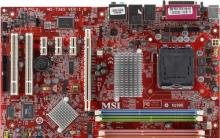Enabling AHCI mode for SATA drives allows you to use NCQ (Native Command Queing), DIPM (Device Initiated Power Management) technology, and also allows you to hot swap drives. All of these features are usually already enabled by default on pre-installed systems. They allow you to increase the performance and speed of information exchange, this is especially true for solid-state drives, for which energy consumption is also reduced.
Here you will learn how to enable this mode on an already installed system. However, it should be noted that in some cases such actions may lead to failure in the system and make it impossible to start it. If this happens, you will have to change a lot of settings, however, it is best to reinstall the system in ahci mode.
Check if AHCI mode is enabled
First, you should check whether this mode is enabled or not. You can do this directly from the system without turning off or restarting your computer. To do this, right-click on the computer, select management in the pop-up menu, and already there go to device Manager. In this section, you will need to find and expand the item called " ControllersIDEATA/ATAPI". In this section, you can see the information you need.
The user can also open the properties of the disk in the same manager and find the necessary information there. 
The second method will require restarting the computer. To get started, the user will need to go to bios / uefi, and then go to parameterssata, here the necessary information will be displayed. 
We use the registry editor to enable the mode
If the wrong mode is selected that the user needs, it can be changed through the registry editor, while it is required that the user entry has administrator rights. First you need to press win + r and write regedit in the window that opens. After that, the necessary utility will open, in which you can edit the registry, on the left side of it, going through the folders, you will have to follow this path: HKEY_LOCAL_MACHINE\SYSTEM\CurrentControlSet\Services\iaStorV. In the last directory you need to find variablestart and set its value to zero. 
Now, in the same directory, you will need to open a folder named StartOverride, it should contain the variable 0, the value of which should also be set to zero. 
After the variable is changed, go to the directory HKEY_LOCAL_MACHINE\SYSTEM\CurrentControlSet\Services\storahci. Here, you also need to find the Start variable and set its value to 0. 
Here you should go to the catalog StartOverride, and set the value variable 0 equal to zero. 
After that, the computer needs to be restarted, while it would be better if it boots into safe mode. After the reboot starts, you will also need to go into the BIOS or uefi and set the drive mode to ahci there. Next, the computer will continue to boot, and then they will download required drivers. When their installation is completed, the computer will ask you to restart again and you should agree with this. The next time you turn on all the modes you need will be active.
Using the command line
Changes can also be made using the command line, which will be launched with administrator rights, in which the following statements should be entered:

The last command restarts the computer in safe mode, so the same can be done the other way. You can press win+r and type msconfig, here go to the boot tab and check the box in safe mode. 
Enabling AHCI in BIOS
Here is a little more about where exactly the setting is located, which should be enabled. To access these settings, press del orf2 when starting the computer. In uefi, the necessary settings are on the tab Integrated Peripherals and is called SATA Mode or Type. 
In BIOS, the desired parameter is usually located on the tab advanced.
If such a conversion failed, then it is better not to suffer further and reinstall the system in the desired mode.
If you installed Windows 10 with the disk controller set to IDE in bios, you can't switch it to AHCI, Windows 10 will not work correctly. After you change the controller mode in the BIOS, Windows 10 will become unavailable. To avoid this, you must follow the instructions in this article.
How to switch in Windows 10 from IDE mode to AHCI
This operation is very simple and does not involve editing the registry or other complex tasks. You must do the following.
Need to download" Windows 10 in safe mode" as described in the following, or use any other method to boot into failsafe mode:
- Start Windows 10 in Safe Mode
- Without waiting for the system to boot, press another key to enter BIOS your computer - F2, F10, Del. Find in the settings and change the disk controller mode from IDE on the AHCI.
- Save your BIOS settings and continue to boot Windows 10 in Safe Mode.
- After Windows 10 starts in safe mode, restart your computer and start it normally. The system should boot without any problems and should be in AHCI.
Before you start searching and thoroughly studying information on how to enable AHCI in Windows 10, it is important to understand what AHCI is, why you need to connect this technology, whether all users, regardless of any other circumstances, need to expose their PC to such manipulations.
AHCI allows you to reorganize disk space in order to improve performance
Do not be lazy and get acquainted with a little theoretical information regarding the appearance in the computer environment of such a new mode as AHCI.
The specified theoretical knowledge will allow you to make the right responsible decision related to the inclusion of this mode on your personal computer.
The focus of new technologies
If you are a prominent representative of PC users who cannot imagine doing work tasks without computer equipment, if you want to find time in the evening to “wander” on the World Wide Web and get acquainted with hot news, play cool games, you have certainly heard a lot about the fact that over the past years, developers have directed their efforts to modernize disk space.

AHCI mode allows you to increase the performance of iron
Over time, the hard disk has grown in size, so it was very important to find ways to increase the performance of the disk subsystem.
Only after the new interface and the SATA standard appeared, the user was offered three unique technologies.
The first "Hot Plug" technology allows the PC user to instantly perform actions with the drive, including turning it off without turning off the electronic computer itself.
Yes, this technology is useful only for those who have several hard drives installed on their computer. The new technology significantly saves time to perform these tasks.
The second technology "NCQ" is responsible for the order in which service tasks are performed. It is it that helps to increase the speed of hard drives. This technology also accelerates the SSD, which also favors quickly solving problems associated with an incredibly huge queue of incoming commands.
The third technology "TRIM" is focused only on modern SSD drives. It contributes to a significant acceleration, as well as an increase in the operational life of the SSD.
But specifically, AHCI is aimed at using the capabilities of SSD, SATA and HDD. To experience an incredible increase in speed, it is important that the SATA controller operates in AHCI mode.

Checking for AHCI
Having plunged headlong into a theoretical vacuum, convinced that the AHCI mode for Windows 10 is important, many will express a desire to turn it on as soon as possible.
It is important to understand that new computer equipment on which Windows 7 or 10 is installed is already accompanied not only by the automatic connection of the mode, but also by the automatic installation of drivers. If you still have doubts about whether the specified mode is supported, whether it is installed on your PC or not, you can use useful tips and find the answer to this question on your own.
Mode Check Algorithm
Checking the AHCI mode in Windows 7 or 10 is easy. Initially, you need to open the "Device Manager", there are two ways to do this.
First of all, click on the "Start" menu, go to the "Control Panel" menu. In the window that opens, in the first rows of the general list there will be such an important “Device Manager” for you.
You can also open it by typing "Device Manager" in the search bar.
In the "Device Manager" that opens, it is easy to find the line IDE ATA / ATAPI controllers. Click on it to open this section and show its contents.
If AHCI mode is installed in Windows 7 or 10, and the appropriate drivers are installed along with it, in the sublist that opens, you can find something that resembles one of the entries:
- Standard AHCI1.0 Serial ATA Controller;
- Intel(R)5 Series6 Port SATA AHCI Controller.

Note that the key to both of these entries is the presence of the word "AHCI" itself. Unfortunately, the absence of the specified word indicates that this mode is disabled for you, not installed.
In particular, if the word “IDE” flashes in this line, then you can confirm that the desired mode is not installed for you, you will have to work hard to remove “IDE” and install AHCI.
If you really want to change everything, then direct your efforts to familiarize yourself with how to enable AHCI mode in Windows 7 or 10.
Turning on the mode
If Windows is already installed on your smart machine, you will have to make important changes to the registry of the system itself. Following the recommendations of experienced users, you will definitely succeed and be crowned with great success.
The main thing is not to make your own fantasy adjustments, especially in cases where you are not familiar with this kind of manipulation.
Mode Connection Algorithm
First of all, you must learn that the AHCI mode must be enabled before installing the operating system, otherwise the operating system will simply not boot on the next reboot.
Run the registry editor, for this you can also type the "regedit" command in the search bar.
In the registry that opens, you will have to carefully review all available branches to find "HKEY_LOCAL_MACHINE\SYSTEM\CurrentControlSet\services\msahci".
On the right side of the open window, you can find the “Start” key, which you will have to edit, respectively, click on the “Modify” parameter.
A new window will open again in front of you, in which you will need to set a numerical parameter. Most often, by default, when the mode is disabled, you can find the number 3 there, and you should change it to 0.
This completes the work with the registry, close all windows and restart your PC.
At the time of operating system startup, call the BIOS. This needs to be done in order to make some changes to enable AHCI on the motherboard.
It's easy to figure out how to change the BIOS IDE to AHCI. Immediately after loading the BIOS, go to the "Advanced" tab, and then in the list that opens, find the line "SATA Configuration", click on it. A small window will immediately pop up, in which there will be only two options to choose from: IDE and AHCI. Choose the second item.

If you have done everything as prescribed by the algorithm, then at startup the operating system will detect new hardware and automatically install the drivers.
There are times when the user has to do the opposite, look for ways to disable AHCI in the BIOS.
It is easy to guess that in order to implement your plan, you will have to follow the same path as described above, only in reverse order. It is advisable to start by switching the new mode to IDE in the BIOS, and then make all changes to the registry. So, how to disable AHCI, you can figure it out simply even on your own.
So, the desire to connect the AHCI mode is justified by the emergence of new successful features and technologies. It is not difficult to perform these actions if you have patience, attention and the appropriate algorithm, how to do it all.
Enabling and configuring the AHCI mode is worth every user who wants to improve and expand the capabilities of the computer in working with SATA hard drives and, especially, SSDs.
The mode allows you to increase the speed of your computer due to the increased speed of data access, and to activate it, you need to perform just a few simple steps.
Before considering the options for enabling the mode, you should first familiarize yourself with its features and the principle of operation.
What is AHCI
The interface of modern SATA hard drives that support data transfer rates from 1.5 Gb / s to 6 Gb / s is capable of operating in two modes:
- AHCI.
The first provides compatibility with older devices (drives manufactured in the 2000s). The speed of even the most productive drives in this mode is not much different from those very outdated models. The more modern AHCI mode allows you to take full advantage of the SATA interface. For example, disconnecting and connecting disks to the motherboard on the fly, without turning off the computer or with the possibility of minimally moving disk heads to increase speed.
By activating the mode, the user speeds up the launch of files, reading and writing information on disks and increases the overall performance of the computer. And, although the increase may not be so significant (within 20%), for some tasks such an improvement may be important. If you have SATA SSD drives in your work, this option is the only one possible for the device to work efficiently.
IMPORTANT: Should you enable AHCI on an SSD?
When using AHCI mode on an SSD drive, you will only get results if you have a SATA II / III interface, in other cases there will be no performance improvement.
How to check if the mode is enabled
If you are going to enable AHCI mode, make sure that it is not already in use on your computer. If you don't run high-performance applications, you have a powerful processor and enough memory available, you may simply not notice what mode you are working in.
You can check if AHCI is enabled or disabled in this way:
- First you should go to the properties of the computer (Start menu, item "Computer", sub-item "Properties" in the context menu);
- Open device manager;
- Open the IDE ATA/ATAPI controllers section;
- If there is a device with AHCI in its name, the mode works. If there is no such disk in the list (and you do not have an outdated IDE hard drive, but a more modern one), you will have to turn on the mode yourself.
The second way to check if AHCI is working is to restart the computer and go to the BIOS menu (using one of the available options - it differs slightly for different motherboards and laptops, although most often it consists in pressing the function keys - from Esc to F12).
Having entered the BIOS (or UEFI), make sure in which mode SATA operates by finding the item SATA Mode or SATA Configuration.
Tip: With the IDE mode set, you should not immediately switch it to AHCI and save it - especially if you have Windows 7.
How to enable AHCI mode
Enabling this mode on a computer can be done directly from the BIOS.
At the same time, if you have Windows 7, after trying to boot the system, an inscription like 0x0000007B INACCESSABLE_BOOT_DEVICE will most likely appear on the screen, indicating the impossibility of working with the disk. Sometimes the same situation occurs with Windows 8 and 10, but the likelihood of a message appearing is less - most often the computer starts up or starts to constantly reboot.
The situation will be completely different if you select the AHCI mode before installing the system. This will allow the software from the installation disk to recognize the HDD or SSD settings during the installer launch process, and there will be no problems starting the mode.
Difficulties begin only if the system is already installed on the drive, and the user is going to change the IDE parameter to SATA and enable NCQ (Native Command Queuing, an extension of the SATA protocol that significantly increases the speed of working with information by optimizing the order in which commands are received). In this case, you will have to use either the registry editor or safe mode, depending on the operating system. If none of these actions provide the desired result, all that remains is to enable AHCI and reinstall the system.
For Windows 7
One of the most popular operating systems today, Windows 7, requires the use of the registry or a special utility to switch to AHCI mode. The first option includes the following steps:
- Launching the registry editor (Win + R to open the Run menu, entering the regedit command and confirming the changes);
- Navigate to HKEY_LOCAL_MACHINE\SYSTEM\CurrentControlSet\services\msahci;
- Going to the Start item, whose default value is 3, and changing it to zero;
- Switching in the same subsection from the msahci item to IastorV and searching for the Start parameter;
- Changing the triple to zero;
- Closing the editor.
Now it remains to restart the computer and enable the desired AHCI mode in the BIOS menu. After the system boots, Windows 7 will automatically install drivers for all drives connected to the motherboard, and then require another reboot to make changes. The last step in setting the mode is to check whether the write cache mode is enabled in the disk properties. If it is not enabled, the function should be run.
Another option is the Microsoft Fix it utility, which allows you to get rid of errors after enabling the new mode (you can download it from the official Microsoft website). After launching and choosing the appropriate action to correct problems, the application will automatically make all the necessary changes, and the error message will no longer appear.
For Windows 8 and 8.1
If Windows 8 or 8.1 is already installed on the computer, you can use safe mode to configure the AHCI mode. To do this, when an error occurs:
- Return IDE mode to BIOS;
- to restart a computer;
- Run the command prompt as administrator ("Start" / "All Programs" / "Accessories");
- Enter the command bcdedit / set (current) safeboot minimal
- Press the enter button;
- Restart PC and enter BIOS;
- Enable AHCI mode;
- Run the command line again;
- Enter the command bcdedit /deletevalue (current) safeboot;
- Reboot the system again, after which Windows should stop giving an error message.
If your system is running on an Intel processor, there is an additional option to enable AHCI using a utility from this manufacturer (this method does not work for AMD).
To use it you should:
- Download the f6flpy file (mode driver) from the official Intel website, choosing the appropriate version (x32 or x64);
- Download the SetupRST.exe file from the same resource;
- Open device manager and manually install the new f6 AHCI driver instead of SATA in the properties of your hard drive;
- Reboot the PC and enable AHCI in BIOS (UEFI);
- Run the SetupRST.exe file, which should fix the problem automatically.
For Windows 10
Windows 10 also allows you to use the utility for Intel processors, reinstall the system and safe mode to fix the error when switching the mode. But the most effective option would be to use the registry editor, which is slightly different from the similar method in Windows 7.
To use this method you need:
- Log in as administrator;
- Run the registry editor in one of the available ways (the easiest way is through the "Run" window and the regedit command);
- Go to HKEY_LOCAL_MACHINE\SYSTEM\CurrentControlSet\Services\iaStorV and find its Start parameter by changing its value to 0;
- Find the parameter with the name 0 in the adjacent Services\iaStorAV\StartOverride subsection, setting the zero value for it as well;
- Go to the Services\storahci subsection, reset the Start parameter;
- In the Services\storahci\StartOverride subkey, set the value to zero for the 0 parameter.
- Close the editor and restart the computer;
- Enter BIOS during system boot and enable AHCI mode.
Tip: It is recommended that you start Windows 10 for the first time in safe mode, for which this option is enabled using the Run menu (Win + R) and entering the msconfig command to display the system configuration window. Here you need to select the "Download" tab and check the safe mode item, indicating the "Minimum" option.
Fig.9. Mode switching in UEFI interface
For the standard BIOS interface, you can go to its settings by pressing the corresponding function key during boot. For example, F2 or F12, depending on the motherboard or laptop model, if the setting is made for it.
After the first boot, Windows 10 will install all the necessary drivers to work with AHCI, and will not generate any errors in the future. At the same time, the speed of working with data should increase - especially if the disk has a SATA III interface.
Other features of the mode
For legacy Windows XP, there is no option to set AHCI mode. During its development, this option was not even assumed. If you really want to, the driver you need is easy to find on the net and integrate into the system. Process instructions can also be found on the Internet, but we do not recommend performing such actions. First of all, because the processor and the entire computer, which only supports the Windows XP system, setting the AHCI mode is unlikely to significantly help speed up. Second, significant differences between drivers increase the chance of an error that could result in data being lost from the disk.
For Windows Vista, the process of enabling the mode is the same as for the 7th version of the system - that is, using the registry or a utility. And Windows NT can be configured similarly to the recommendations for XP. There are driver options for other systems - from Unix to MacOS, as ssd drives and SATA are gaining popularity among users of any system.
conclusions
In most cases, after performing the appropriate action on the system, AHCI mode starts working normally, and the system runs a little faster. If no results were achieved, you can try to reinstall the system after changing the mode - this may take longer, but it guarantees the result.











Wargame: Red Dragon not starting?
Sad escobar "The face of the judicial system of Ukraine"
ROME Total War - how to unlock all factions?
How to turn off the TalkBack feature?
Overview of alternative firmware HTC Desire A8181 Bravo How to install the firmware file for HTC Desire